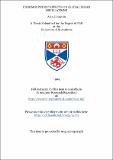Chromospheric effects on global solar oscillations
Abstract
A study has been made of the global solar oscillations known as p-modes. The Sun is represented by a plane-parallel stratified plasma. Solutions are found to the magnetohydrodynamic equations of motion in such a plasma, and normal mode frequencies are calculated by applying realistic boundary conditions to these solutions. The normal modes model solar p-modes. For a model consisting of an isothermal chromosphere with a uniform horizontal magnetic field, it is demonstrated that modes may form at all frequencies. Consideration is also given to the related problem of vertical propagation of fast magnetoacoustic waves in a uniform magnetic field. An investigation is carried out into the observed solar cycle variations in the frequencies of p-modes in the classical, low frequency range (1-5 mHz). A possible mechanism for the observed "turnover" effect is discussed. Through the use of a modified Bohr- Sommerfeld condition, the effect of a non-isothermal chromosphere is also considered, and a physical description of chromospheric effects on p-mode frequencies is given. The formation of modes above the acoustic cut-off frequency is investigated. The theoretically calcidated forms of frequency shift curves in this high frequency range agree well with observations. The special case of modes of degree zero is also briefly examined. A mathematical formulation for such modes is constructed, and frequency shifts are determined for a simple chromospheric model atmosphere.
Type
Thesis, PhD Doctor of Philosophy
Collections
Items in the St Andrews Research Repository are protected by copyright, with all rights reserved, unless otherwise indicated.

